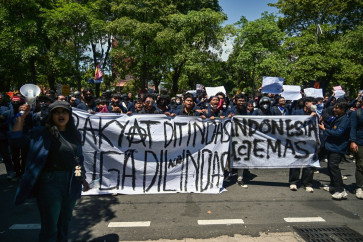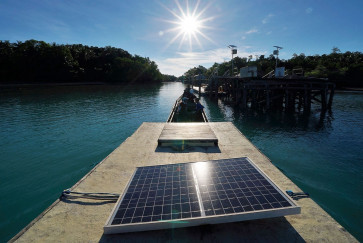Popular Reads
Top Results
Can't find what you're looking for?
View all search resultsPopular Reads
Top Results
Can't find what you're looking for?
View all search resultsBank Danamon to continue diversifying revenue streams
Publicly listed private lender Bank Danamon will continue diversifying its revenue streams this year as it targets a double-digit net profit growth in 2018
Change text size
Gift Premium Articles
to Anyone
P
ublicly listed private lender Bank Danamon will continue diversifying its revenue streams this year as it targets a double-digit net profit growth in 2018.
The bank posted net profit growth of 38 percent to Rp 3.68 trillion (US$268.64 million) in 2017 from Rp 2.66 trillion in 2016 on the back of double-digit growth in several credit segments.
Bank Danamon president director Sng Seow Wah attributed the increase in net profit to increased revenue channels, better funding costs, cost discipline in managing operating expenses as well as improved asset quality.
The bank’s loan growth for the Small and Medium Enterprise (SME) segment grew by 10 percent to Rp 28.5 trillion last year. Its enterprise credit segment, which comprised corporate banking, commercial banking as well as financial institutions, grew by 4 percent to Rp 37.6 trillion over the same period.
Meanwhile, consumer segment loans grew by 36 percent to Rp 6 trillion.
Outside micro banking, Bank Danamon’s total credit portfolio and trade finance grew by 5 percent in 2017 to Rp 122.9 trillion compared to the previous year. When microloans were included, which the bank channeled through its Danamon Simpan Pinjam unit — a unit that is labeled as mass market credit, the bank’s loan growth was recorded at around 2 percent, said Bank Danamon chief financial officer Satinder Ahluwalia.
Bank Danamon’s subsidiary, automotive financing firm Adira Finance, also posted a 2 percent growth in its financing to Rp 45.2 trillion in 2017 compared to the previous year.
Wah said the bank would continue its efforts to diversify its revenue streams.
“Apart from microfinancing, now the bank has put in a lot more resources to diversify our revenue streams. This strategy has yielded us good results, so we will continue with this strategy,” Wah said in a press briefing in Jakarta on Monday.
Ahluwalia added the bank was aiming for a 6 to 8 percent loan growth this year, in his conservative estimation, citing good macroeconomic indicators in the country that would positively encourage banks to channel more loans.
In an optimistic projection, Ahluwalia added he hoped the bank’s loans would grow by 8 to 10 percent this year.
“We are optimistic that the economy is picking up,” he said, while adding that the positive momentum generated from economic growth would create more opportunity for banks to record positive growth.
Bank Danamon has also managed to reduce its Non-Performing Loan (NPL) by 9 percent to Rp 3.4 trillion as of 2017. Its gross NPL was recorded at 2.8 percent over the same period, compared to the 3.1 percent that was posted in the previous year.
Meanwhile, the bank’s Loan to Funding (LFR) ratio stood at 93.3 percent as of 2017. Current and Savings Accounts (CASA) were up by 4 percent to Rp 50.5 trillion.
The bank’s positive momentum has caught the eye of international banks, such as the Bank of Tokyo-Mitsubishi UFJ, the banking arm of diversified Japanese conglomerate Mitsubishi UFJ Financial Group (MUFG), which is currently in the process of acquiring a controlling stake in Bank Danamon.
“Our focus in the next three to six months is to finish stage two [of the acquisition process], for which we still need the approval of shareholders and regulators,” said Ahluwalia.
Ahluwalia was referring to the acquisition plan for Bank of Tokyo-Mitsubishi UFJ to get an additional 20.1 percent stake from Asia Financial Indonesia, which currently held a majority stake in the bank.
Bank of Tokyo-Mitsubishi UFJ succesfully acquired 19.9 percent of Bank Danamon’s stake with a total investment of Rp 15.87 trillion in December last year.
Upon completion of stage two, the increased stake would put Bank of Tokyo-Mitsubishi UFJ up to a 40 percent stake in Bank Danamon, which is the limit set by the Financial Services Authority (OJK) regulation. Bank of Tokyo-Mitsubishi UFJ would then seek approval from the OJK to eventually increase its stake to over 70 percent when the acquisition process was finished.
Bank Danamon director Rita Mirasari said the bank would seek approval from its shareholders at its next general shareholder meeting (RUPS) for the completion of stage two, which was scheduled to be held on March 20.










